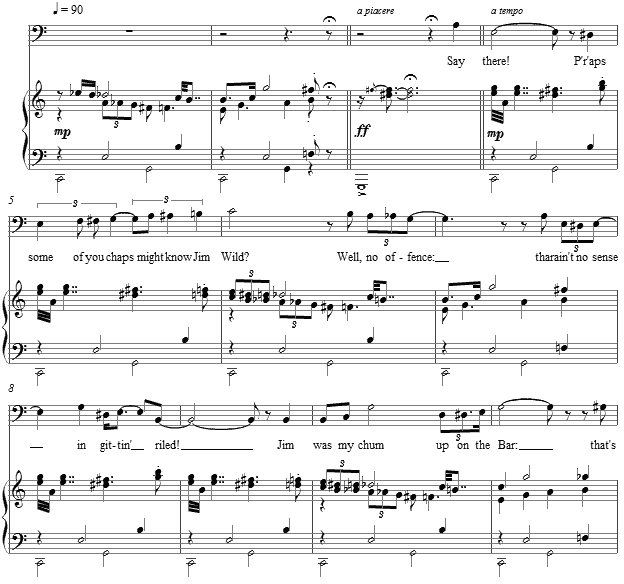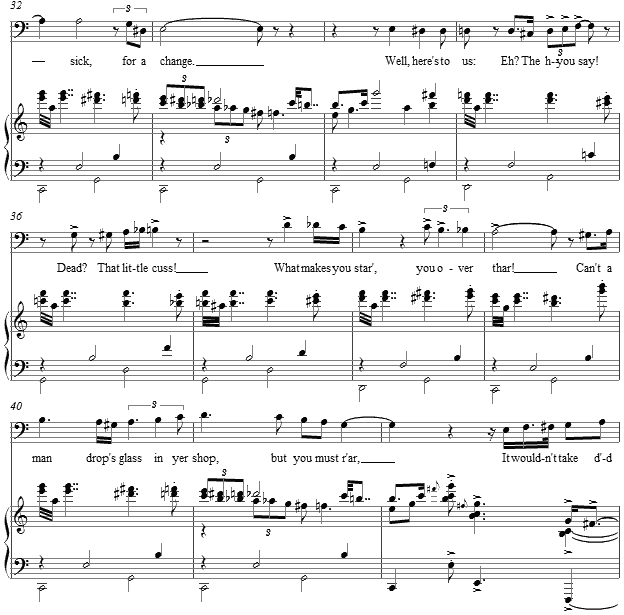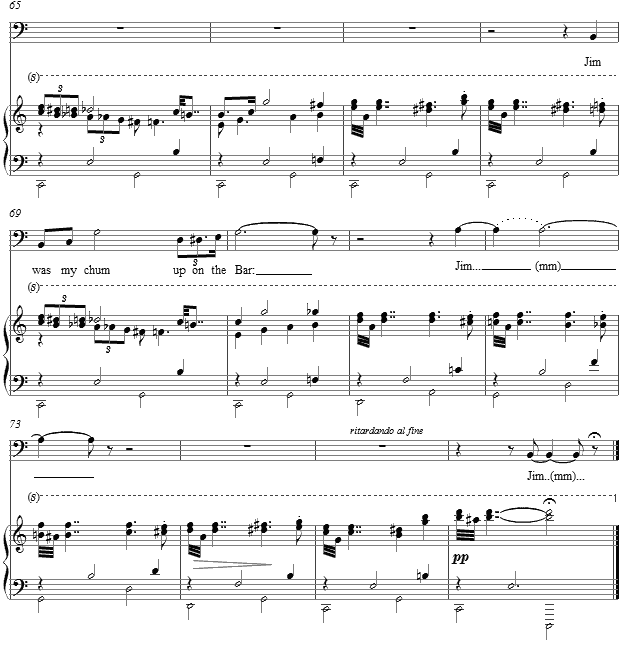Music and Texts of GARY BACHLUND
Vocal Music | Piano | Organ | Chamber Music | Orchestral | Articles and Commentary | Poems and Stories | Miscellany | FAQs
Jim - (2008)
Bret Harte
for baritone and piano
Say there! P’r’aps
Some o’ you chaps
Might know Jim Wild?
Well,— no offense:
Thar aint no sense
In gittin’ riled!
Jim was my chum
Up on the Bar:
That’s why I come
Down from up yar,
Lookin’ for Jim.
Thank ye, sir! You
Ain’t o’ that crew,—
Blest if you are!
Money? Not much:
That ain’t my kind;
I ain’t no such.
Rum? I don’t mind,
Seein’ it’s you.
Well, this yer Jim—
Did you know him?
Jes’ ‘bout your size;
Same kind of eyes;—
Well, that is strange:
Why, it’s two year
Since he came here,
Sick, for a change.
Well, here’s to us:
Eh?
The h— you say!
Dead?
That little cuss?
What makes you star’,
You over thar?
Can’t a man drop
‘s glass in yer shop
But you must r’ar?
It would n’t take
D—d much to break
You and yer bar.
Dead!
Poor—little—Jim!
Why, thar was me,
Jones, and Bob Lee,
Harry and Ben,—
No account men:
Then to take him!
Well, thar— Good-by—
No more, sir—I—
Eh?
What’s that you say?
Why, dern it! — sho! —
No? Yes! By Joe!
Sold!
Sold! Why, you limb,
You ornery,
Derned old
Long-legged Jim.[ 5 pages, circa 3' 40" ]
Bret Harte
For more information on Bret Harte, please see my settings of three other texts under the title, Harte Songs, conceived originally for baritone and piano.
Realism in literary theory is the depiction of "life as most people live and know it." A subset of this is Regionalism in which the customs, habits and characteristics of a particular place are highlighted, often through the use of "local color." This can be shown in a particular dialect as this poem shows well. The text is most certainly filled with a sense of a particular subset of what is often referred to as Americana. Just as the famous black poets of the mid 19th century and through in the 2oth century flavored their poetry with regional color and dialect, so does Harte with the Western influences of this text.
The scene is set in a bar room, as a stranger comes into a saloon to inquire after an old friend, Jim. The conversation is one-sided, as we are left to imagine the other characters in this little drama of some small intrigue and discovery. The accompaniment is that music hall variety as might have been heard in some saloon, playing as the stranger enters, and for a moment the repetitive piano stops and then takes up the "old song" over which we listen in on one side of the conversation.
While the accompaniment continues on in a somewhat nonchalant fashion, the stranger becomes more agitated as the conversation deepens. The stranger addresses even more people in the saloon, though we know little of any of them; it is therefore up to the singer to populate this scene with those invisible personages.
After the largest of the potential bar room fights is defused, the piano accompaniment continues on as the conservation draws to a close and the stranger muses on his "chum." Closing the name, Jim, to a hum should be audible over the accompaniment, and for this reason is it marked piano.
The score for Jim is available as a free PDF download, though any major commercial performance or recording of the work is prohibited without prior arrangement with the composer. Click on the graphic below for this piano-vocal score.



